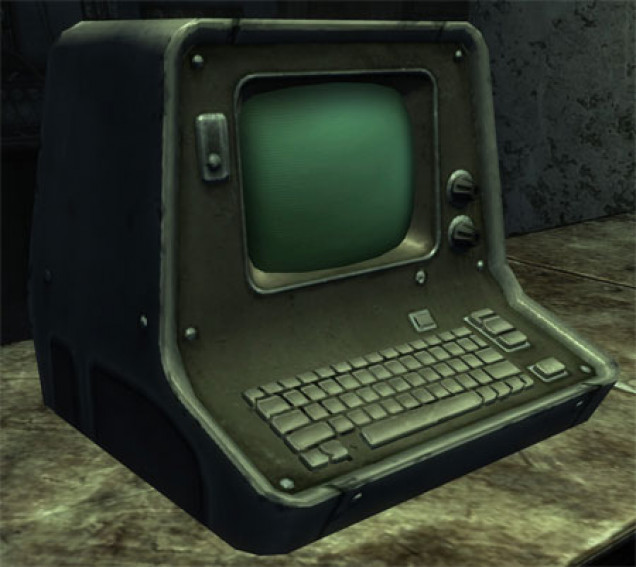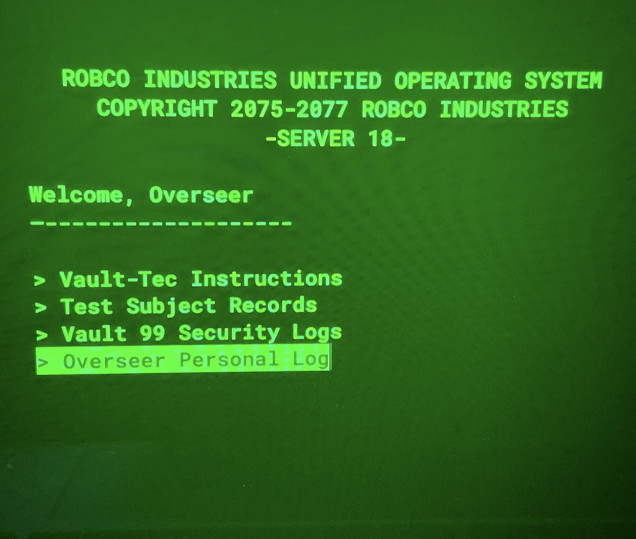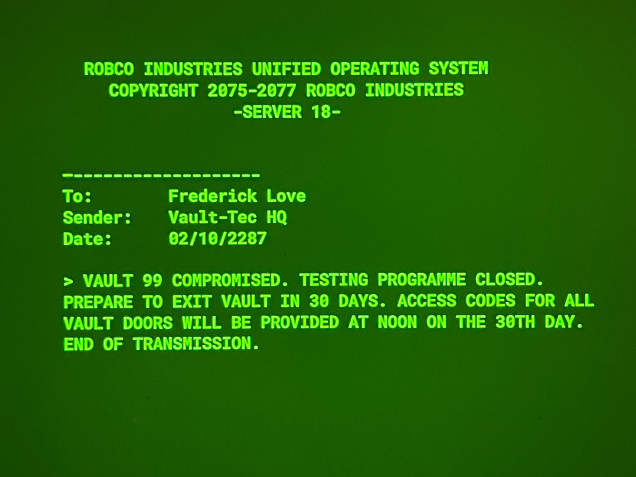
Escape Vault 99: A Dungeonalia Inspired Fallout Adventure
Battle Report - Part 3 (of 4)
 200 years may have passed, but the terminals and their software had not advanced, so Leeland was able to hack his way in.
200 years may have passed, but the terminals and their software had not advanced, so Leeland was able to hack his way in.Lucie and John gathered round while Leeland browsed through the terminal’s menu, taking each section in turn and reading the contents in detail. Audible gasps were regularly heard from all three of them as the true secrets of Vault 99 were revealed!
 I mocked up this Home Screen for the Overseer's terminal in the true Fallout style. All manner of juicy information awaits!
I mocked up this Home Screen for the Overseer's terminal in the true Fallout style. All manner of juicy information awaits!The crew spent a long time poring over all of the information in the terminal. It was all there. The reason for the inner vault, records of tests performed on its inhabitants, and the Overseer’s personal communications.
To summarise..
The inhabitants of the inner vault were sealed in before the outer vault was populated. The outer vault residents were aware of the inner vault, but only the Overseer and his close science team (and their subsequent generations) knew of its true purpose. Even the inner vault Overseer had no knowledge of this. He was also a test subject who naturally assumed the inner vault was all there was. He went to his desk every day to lead his underground society, following the procedures he was trained on, and actioning the limited instructions that came through from Vault-Tec.
However, it transpired that Vault 99 had been installed with some experimental cryogenic technology, and the inner vault residents were its test subjects. Vault-Tec had been working on cryogenic technology for many years, and had some success in putting subjects into a deep freeze and awakening them after a long period of time. However ‘thaw sickness’ was common, and some subjects didn’t fully recover all of their cognitive function. In rare cases, cell damage meant the subject did not wake up at all. It was therefore not considered safe for commercial use, and it was certainly not something a person would undergo willingly unless they had no choice.
A better solution was being sought, and Vault 99 was to test one such solution. Using a combination of drugs administered via inhalation of an odourless gas, and lowering the room temperature such that metabolism slowed almost to zero, but not so cold that cell damage was caused, the theory was that a person could be frozen and unfrozen repeatedly without suffering any noticeable ill effects or long term damage. It wouldn’t pause the ageing process completely, but ought to slow it such that it was almost imperceptible.
The scientists at Vault-Tec were so confident in this new technology that they claimed a person could be frozen and unfrozen, while they slept, without their knowledge. They petitioned for a live test to prove the theory. Given the potential uses for such a technology, the Vault-Tec executives agreed to set up Vault 99 as a testing ground. The inner vault residents were to be subjected to this procedure, without their knowledge, for increasing durations of time.
The early tests were intended to induce a freeze for a few hours, gradually increasing until ultimately the duration was a number of years. Science staff in the outer vault would monitor the test subjects, using remote viewing technology, as they went about their days. They were looking for any signs that the residents were becoming aware of the tests, whether there were any noticeable behavioural changes, or whether their cognitive function became impaired at all.
The test logs showed that the trials were actually very successful. When the vault went to bed, the gas was released into the bedrooms. Once the subjects were unconscious, the temperature was lowered. The process was reversed a few hours later, and nobody seemed to notice. The occasional morning headache or grogginess was passed off easily enough as ‘one of those things’ and no-one became suspicious. Hours became days, days became months, months became years – it all went to plan. The scientists claimed victory, but Vault-Tec commanded that the trials continue, for longer and longer periods. A new generation of scientists were required as the first generation ‘retired’ and there were instructions as to how the Overseer would ensure that the ongoing secrecy of the project was maintained.
And so it was explained how two years for Leeland and Lucie had represented two hundred years of real time. Lucie was crying, unable to comprehend what she was hearing. John was agape. This was all new news to him as well. Leeland put an arm around Lucie as he continued to work through the terminal entries.
It was within the Overseer’s personal logs that the reason for the recent events became clear. As communications from Vault-Tec had dwindled over time, the Overseer had become increasingly frustrated. He was getting no news about the current state of the world or when it might be safe to be released. The inner vault Overseer (who was called Jeremiah Houston) had no knowledge of the outer vault, or its leader, but the outer vault Overseer (Frederick Love, 6th Overseer of Vault 99) became suspicious that perhaps the inner vault was receiving communication that he was unaware of. His attempts to remotely hack the inner vault Overseer terminal were clumsy and had actually alerted Jeremiah to his presence. Computer expertise dwindles as it is passed down from generation to generation in a closed environment, but Jeremiah still remembered the training he had received directly. He was a far superior technician and was able to reverse engineer the hack and gained a direct line of communication to Frederick as well as access to all of the information our crew were currently reading!
Jeremiah had demanded that the inner vault be released. Frederick had responded to say that his orders from Vault-Tec were non-negotiable, but even if he wanted to release them he had no way of doing so. The door was remotely controlled from Vault-Tec HQ.
A copy of the email was not on this terminal, but Jeremiah must clearly have written a very terse communication directly to Vault-Tec. In Frederick’s logs, dated only two months ago, was a high priority message from Vault-Tec saying simply:
There followed a number of unanswered messages from Frederick to Vault-Tec, demanding answers, asking if it was actually safe to leave, how to communicate this to the residents, what was to become of the inner vault. It made for upsetting reading.
Next Frederick turned his questions to Jeremiah, asking what he had done, what he had been told. Again, no replies.
After that there were a number of redacted messages which ended abruptly, exactly 30 days after Vault-Tec’s bombshell.
“Can you access the redacted messages Leeland?” asked Lucie.
“No,” replied Leeland. “They’re gone.” He spent a while entering text prompts that Lucie couldn’t follow, and finally he said “I can tell you one thing though. The messages were redacted remotely. Not from this terminal.”
“But who would do that?” wondered John. “Vault-Tec?”
“Possibly,” speculated Leeland. “But if it was Vault-Tec, wouldn’t they have wiped the entire terminal? This is really incriminating stuff for them.”
“We may never know,” said John. “But I can fill in the rest from my perspective.”
John went on to explain that over the course of those 30 days, Frederick had started acting more and more strangely. He spent all day in his office, holding secret meetings with certain members of the vault personnel. Mostly the scientists but also influential members of the general populace. On that 30th day, the alarms had sounded, and Frederick’s voice sounded over the loudspeakers. He announced that the inner vault was about to be breached. The residents would emerge armed and hostile. All security should take position along the exit route and shoot on sight.
“And so we did,” recalled John. Adding more detail to the brief version of events previously shared. “The inner vault opened, the residents poured out in a surge of violence, and we fought. We fought for about an hour before we were overwhelmed. They were more prepared than we were and their mass of numbers pushed through each of our defensive positions one by one. There were many casualties. Those of us still in the fight broke and ran for the cover of adjoining passages as the hostiles made straight for the main door. When we finally came out from hiding they were gone. As was Frederick, the science team, and most of our vault compatriots. Only a handful of us remained, all as confused as each other.”
“The part I don’t understand,” said Lucie, “is how come this all happened without us noticing? Tell me again how long after this happened was it that we met you John?”
“30 days,” replied John. “We spent the first couple of weeks giving the fallen a decent burial, cleaning up the mess, and trying to find a way to close the door. With it stuck open, all manner of creatures started to find their way in. You’ve encountered some of them of course. We’ve been fending them off ever since. We were more than surprised when we saw you, thought you were the escapees who had come back to finish us off.”
“30 days?!” exclaimed Lucie. “We must have been unconscious that whole time!”
“Yes,” concluded Leeland. “Jeremiah must have found a way to gas our room from his terminal. Put us to sleep while he and his conspirators carried out their plan.”
“Jeremiah?” asked Lucie. “Why would he do that? And why just us?”
“Because,” continued Leeland, “he knew we would try to stop them…”









































































Leave a Reply